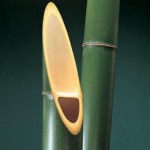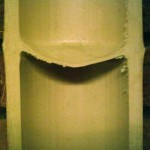Bamboo possesses impressive physical properties. Its light weight combined with its high pressure, tensile and flexural strength, as well as the ease with which it can be processed, make the plant an ideal construction material in numerous fields of application. Bamboo culms are comprised of nodes (knots) and internodes (hollow cavities), which are divided by thin, horizontal-lying partitioning walls, so-called diaphragms. The culms are always hollow, their diameter and wall strength decreasing the higher they grow, with the culms growing together and merging into massive stalks. Length and diameter of the stalks vary from species to species. The largest species have a diameter of up to 30 cm and reach heights of 30 meters and more. Depending on the type, the stalks can grow very straight, in serpentine lines or slights curved. Bamboo stalks have no secondary growth (meaning thickness growth), as is the case with trees, but rather sprout out of the soil with their final diameter. The stalks push themselves upwards, telescopically, from node to node until they reach their final height.
- … separated into individual chambers
- … stabilized by partitioning walls
- … higher flexural strength at smaller diameters
This is why the age of bamboo is not measured by the circumference of the plant, but is determined in every subspecies on the basis of the tone, the surface structure and color. Bamboo only blossoms once during its life cycle and then completely dies off following the blooming. The period of time until blossoming can last up to 100 years.
Bamboo culms are a prime example of plant-based lightweight design. At an average weight of 600 kg/dm3, its tensile strength measures up to 392 N/mm2. In their mechanical properties, bamboo culms are far superior to most construction timber. Its flexural strength is especially high thanks to the composition of the stalk structure. Bamboo also has a different fracture behavior than wood. There are never any spontaneous fractures along the entire culm. Instead, only individual fibers will tear out. At the very worst, the spread of the tear will be stopped at the next knot by the interwoven fibers.
The high silicate content of the outer layers also ensures that bamboo has a low flammability (DIN 4102). Tests show that vertical supports made from bamboo can withstand fire longer than either wood or steel, and that they even retain a certain load capacity in a charred condition. The reason for this is the way bamboo burns. The fire doesn’t affect the culm as a whole, but rather moves along it in stages, from node to node. The dense structure of the nodes inhibits an explosive spread of the fire.
The rounded hollow form is far superior to all other technically produced cross-section designs in terms of strength, especially to that of the solid cross-sections that one generally finds employed with wood. The weight to payload ratio even surpasses that of reinforced concrete. The fact that bamboo also exceeds the tensile strength of steel by two and a half times the amount is more than astonishing.


